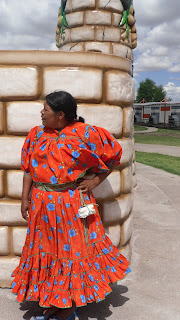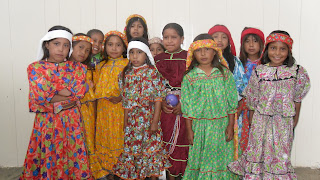For several months, I was in the habit of sitting down with the women in front of their houses or the little church and watching them sew. Sewing is an enormously important activity for the rarámuri women, both in the Sierra and the desert, and has fascinating anthropological implications. For example, sewing is strictly a womens' activity, and as I have sat for hours chatting with women as they sew, I have observed how this activity brings the women together to not only work, but talk. They share news, watch each other's children, have snacks together, and ultimately form very strong bonds. The "sewing circles" are also important economic activities, since the women are either making dresses which they plan to bet on a race, or they are making little rarámuri dolls ("monitos," they call them) which they sell at intersections for 10 pesos each. The ritual aspect is seen in so many places: in the repetition of the activity on a daily basis, in the colorful materials the women consider most beautiful, in the same dress pattern used over and over again.
For months I observed all of these things, but the actual practice of sewing--what it feels like to hold a needle, to make stitches, to choose and combine patterns and fabrics--did not form part of my experience with the rarámuri. It wasn't until two months ago, when two friends from New Mexico came to visit, that I finally moved from being an observer in the rarámuri sewing circles to a student, and now a (more or less) full-fledged member.
My first sewing lesson took place two months ago, one March afternoon, when my friend Flora bought several meters of blue, yellow, pink, and flower-patterned fabric and came to Oasis with me. That day, there were several sewing circles in progress throughout the settlement, as there usually are. The women generally prefer to sew outside, because the houses are small, dark, and overcrowded; outside, many can gather at one time and there is plenty of sunlight. I decided to approach Marcela and Susannah, two very kind rarámuri women, and announced that Flora and I wanted to make a rarámuri dress. They said "alright," allowed us to sit down with them, and showed us how to tear fabric into long, wide strips that we would piece together to form a skirt. But prior to tearing the fabric and stitching the pieces together, we spent several minutes discussing what colors to use. Flora suggested some combination, I suggested another, and both were rejected by the rarámuri women. This is when I first came to understand that the rarámuri women are very particular about color combinations and patterns, and there is an entire code of fashion (at least within this settlement) to follow. At their suggestion, Flora and I agreed the full skirt would be pink, with a blue piece in the middle, and a yellow hem.
My sewing lessons continued on a regular basis throughout the next six weeks. Normally, it takes a good rarámuri seamstress five to seven days to complete a full dress; I took six weeks to complete just the skirt! It started to get really embarrassing around week four, because every day women would ask me "are you almost finished?" and then laugh when I showed them my progress. But my teachers kept making me undo stitches and start over every time they were badly done, which happened very often (especially when I was doing the hems--that is by far the hardest part).
Marcela and Susannah were not my only teachers during this process. Esperanza showed me many techniques, especially when it came to making the pleats. Chavela helped me perfect the hem, which requires rolling the fabric into a very thin strip and making tiny, almost invisible stitches. Cuka, Carolina, and Maria Rosa also checked up on me frequently and offered their advice. I moved around to different sewing circles throughout the process, heard different news about different families, learned different sewing techniques, and laughed when one rarámuri woman would tell me that another rarámuri woman was teaching me badly.
Throughout Semana Santa, I sat in the basketball court sewing and watching the rarámuri men dance the ritual "fariseo" and "soldado" dances. In the weeks after, as I moved among the different sewing circles, my favorite one came to be Esperanza'a, Cuka's, Teresa's, and Maria Rosa's. I spent many, many days sitting in a shady patch in front of Esperanza's house with these women, learning new words in rarámuri and trying to understand them as they talked to each other in rarámuri.
Of course, Julissa, Jiovanna, and Lorena were with me throughout the entire experience. For one week, Julissa and Jiovanna even decided that they would learn to sew, and that I would teach them. So I, a chabochi, gave two rarámuri girls their first sewing lessons ever! I cut two strips of colored fabric, gave each girl a needle, and had them make rows of stitches using different colored thread. Julissa got pretty good, and even went on to make a little skirt for a doll, under her mother's direction. Jiovanna is barely six, but her mother says she will have to learn in the next two years.
The entire time I was working on the dress, different women and children would ask me what I was planning to do with it when I finished it. "Are you going to wear it?" several people asked me. "I'm going to bet it on a race," I replied, which always provoked a smile. My mestizo friends would tell me, "it's your first dress, you should keep it as a memory. Don't bet it, what if you lose it?" But I always thought it would be even better if I lost it! Carolina told me a few weeks ago that she recently gave up betting her favorite dresses on races, because it was painful to lose them so often. I can imagine how horrible it must feel to lose your favorite article of clothing. Every woman likes to have a lot of pretty clothes, but even when everything in your closet is pretty, there are always two or three articles that you love above all others. I try to imagine what it would be like to lose my favorite dress--a midnight blue stretch satin Calvin Klein with a sweetheart neckline. It would be fabulous to bet it against another beautiful dress and win both in the end, but I know I would cry if I lost it! After losing one very treasured dress in a bet, Carolina tried to buy it back from the woman she lost it to, but the other woman refused to sell it back. Then the woman moved back to the Sierra and took the dress with her, and Carolina never saw it again. After this incident, Carolina decided to tone down the gambling and now only bets dresses she doesn't love. But I wanted to get into the full betting craze and bet my first dress, the most special one I will probably ever make because it's my first.
Still, the moment I finished it, I knew I didn't want to bet it. I wanted to take it home, show it off to my non-rarámuri friends, who had been tracking my progress almost as carefully as the rarámuri. I just wanted to hold onto it for a few days, try it on, take a couple pictures in it, hang it proudly in my closet. As soon as I finished it, I got up and walked around the settlement to show off my accomplishment. Most of the women were at the entrance, gathering skirts to bet for a race. As soon as Susannah saw me hold up the skirt, she said, "Come on, Victoria, time to bet it." I told her I didn't want to, and she made a face at me. "Come on, Victoria," someone else said. I made a face back, but then I thought, "how many people are actually encouraged to participate in rarámuri bets?" I said, "okay," and tossed it on the ground, prepared to engage in my first skirt-betting experience.
Betting dresses on rarámuri races follows the same basic concept as any other kind of betting: two dresses of equal value must be bet against each other. Just like you wouldn't bet $10 for $5, you wouldn't bet a rarámuri dress of less value for one of greater value. Now, deciding the value of a dress is the complicated part, because it is very subjective. There are some criteria for judging the value of a dress: the quality of stitching is taken into account, as is the newness of the dress. You won't bet a brand new dress for an old, faded one; and you won't bet a dress that is falling apart at the seams for one that is tightly and cleanly stitched. But then you have to take into account the aesthetic value of the dress, and that is highly subjective and very personal. This is the part that makes the betting process take three to four hours total every time. Here is a typical scenario: Rarámuri woman from Team A has a dress that is orange and blue flowers against a green backdrop, with a white hem. She has her eye on a blue dress with pink daisies and an orange hem that she sees in Team B's betting pile. With the help of the assigned intermediary, rarámuri woman from Team A proposes betting her dress against the desired one from Team B. But the dress's owner, who we will call rarámuri woman from Team B, doesn't want to agree to the bet because she thinks Team A rarámuri woman's dress is ugly. So she says: "I'll bet you my dress, but not against the one you propose. Instead, pair it with the green-and-white polkadot I know you have in your house." Team A rarámuri woman doesn't want to, but she is willing to bet a yellow one with purple flowers and a red hem. And so the arguing and debating continues, until both women come to some kind of agreement. This conversation occurs at least fifteen times, when the women feel like being difficult (some women will bet anything against anything, just for fun), and this is why the entire betting process takes up so many hours before the race even begins.
I was really looking forward to seeing what dresses would be offered against mine. As I sat with my team, my team's intermediary took my skirt over to the other team to see if there was any interest in it. I was excited to see what options she would come back with for me. About five minutes later, she returned with a bundle of jungle-green fabric. "This is what they propose to bet your skirt for, so that you can make another dress," ("para que te pongas a hacer otra," were the exact words). My entire team broke into laughter, and then I did too. I'm still not sure if they bet material against my skirt just to mess with me, or because they really think the quality of my stitching is so terrible that they can't find a fair match for it. Either way, it was a hilarious event! In the end, I agreed to the proposed bet, but one lap into the race, the girl from the other team got a cramp in her leg and the race was called off. Everyone's bets were returned to them, so I ended up keeping my skirt for a couple days in the end. However, I'm taking it with me to the settlement every day, and I'm sure there will be another race this weekend, so I hope to bet it then!




















